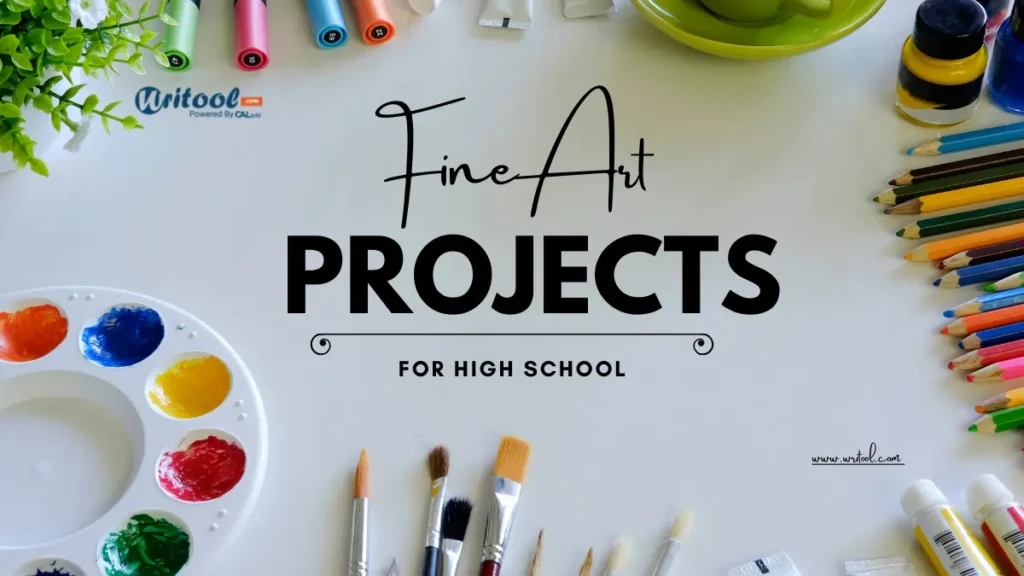Fine art projects in high school are super important for helping students get better at being creative, learning technical stuff, and liking art more. They don’t just make you better at drawing or painting but also help you think better, solve problems, and express feelings. This blog will explore various fine art projects for high school students, giving you a guide on how to do them well.
Also Read: 150+ Exciting Political Science Project Topics And Materials You Need to Explore
5 Benefits of Fine Art Projects in High School
Fine art projects in high school offer numerous benefits that extend beyond developing artistic skills. Here are some of the key benefits:

1. Enhancing Creativity
Fine art projects encourage students to think outside the box and explore new ideas. This creative exploration helps in developing original thought processes and innovative solutions to problems.
2. Developing Technical Skills
Through consistent practice and experimentation with different mediums and techniques, students improve their technical skills in drawing, painting, sculpting, and other art forms.
3. Emotional Expression
Art provides a platform for students to express their emotions and experiences. This expression is essential for personal development and emotional well-being.
4. Critical Thinking and Problem-Solving
Art projects often require planning, problem-solving, and critical thinking. These skills are transferable to other academic and life scenarios, making art education invaluable.
5. Cultural Awareness
Studying and creating art exposes students to different cultures and historical periods, broadening their understanding and appreciation of the world.
100+ Fine Art Projects For High School
Here is a list of 100+ fine art projects for high school students, categorized into different areas.
Drawing Projects
- Self-Portrait Series
- Figure Drawing from Life
- Still Life with Reflective Objects
- Charcoal Landscape Drawing
- Cross-Hatching Animal Portraits
- Architectural Sketches
- Emotion Through Line Art
- Botanical Illustrations
- Surrealist Drawing
- Fantasy Creature Design
Painting Projects
- Watercolor Nature Scenes
- Abstract Expressionist Canvas
- Acrylic Pour Painting
- Portraits in Oil Paint
- Impressionist Landscape
- Pop Art Self-Portraits
- Cubist Still Life
- Mixed Media Painting
- Monochromatic Painting
- Painting with a Limited Palette
Sculpture Projects
- Wire Figure Sculptures
- Clay Busts
- Recycled Material Sculptures
- Plaster Bandage Body Casts
- Kinetic Sculptures
- Foam Carving
- Paper Mache Masks
- Found Object Assemblage
- Soapstone Carving
- Cardboard Architecture Models
Printmaking Projects
- Linocut Prints
- Screen Printing T-Shirts
- Etching on Metal
- Monoprint Techniques
- Collagraph Prints
- Reduction Printmaking
- Stencil Art Prints
- Block Printing on Fabric
- Drypoint Engraving
- Nature Prints (using leaves, flowers)
Mixed Media Projects
- Mixed Media Collage
- Altered Books
- Photo Transfer Art
- Textured Surface Art
- Assemblage Art
- Mixed Media Journals
- Collage Portraits
- Found Object Shadow Boxes
- Fabric and Paper Collage
- Mixed Media Abstracts
Digital Art Projects
- Digital Portraits
- Animated GIFs
- Vector Art Design
- Digital Collage
- Concept Art for Games
- Digital Comic Strips
- Digital Landscape Painting
- Photo Manipulation Art
- 3D Modeling
- Digital Mandalas
Photography Projects
- Black and White Photography
- Thematic Photo Series
- Portrait Photography
- Macro Photography
- Documentary Photography
- Experimental Photographic Techniques
- Photomontage
- Long Exposure Photography
- Street Photography
- Landscape Photography
Art History and Cultural Projects
- Artist Research and Presentation
- Art Movement Reinterpretation
- Cultural Art Projects (e.g., Aboriginal, Native American)
- Historical Art Reproduction
- Modern Interpretation of Classic Art
- Art Inspired by Literature
- Mythology and Art
- Political Art and Propaganda
- Social Commentary Art
- Artistic Movements Timeline
Collaborative Projects
- Class Mural Project
- Group Installation Art
- Collaborative Quilt
- Exquisite Corpse Drawings
- Community Art Project
- Collaborative Storyboard
- Team Sculpture Project
- Collective Art Journal
- Group Printmaking Project
- Class Art Show Curation
Experimental and Innovative Projects
- Light Art Installation
- Interactive Art (e.g., touch-sensitive pieces)
- Art with Natural Elements (e.g., leaves, sand)
- Sound Art
- Kinetic Art
- Wearable Art
- Large-Scale Ephemeral Art
- Virtual Reality Art
- Augmented Reality Art
- 3D Pen Art
Best Fine Arts Project Ideas For High School With Materials
Here are some of the best fine arts project ideas for high school students, along with the materials needed for each project.
1. Self-Portrait Project
Objective: To develop self-awareness and improve portrait drawing skills.
Materials Needed: Graphite pencils, charcoal, erasers, sketch paper, mirrors or reference photos.
Instructions:
- Introduction: Discuss the history and significance of self-portraits in art history.
- Preparation: Have students study their reflections in mirrors or use reference photos.
- Sketching: Start with basic shapes and proportions of the face.
- Details: Gradually add details such as eyes, nose, mouth, and hair.
- Shading: Teach shading techniques to create depth and realism.
- Critique: Conduct a group critique session to provide constructive feedback.
Outcome: Students gain a deeper understanding of their features and improve their technical skills in portraiture.
2. Abstract Expressionism Painting
Objective: To explore emotional expression and abstract art techniques.
Materials Needed: Canvas, acrylic paints, brushes, palette knives, and other painting tools.
Instructions:
- Introduction: Discuss the Abstract Expressionism movement and key artists like Jackson Pollock and Mark Rothko.
- Conceptualization: Encourage students to think about emotions or themes they want to express.
- Experimentation: Allow students to experiment with different tools and techniques, such as dripping, splattering, and layering paint.
- Creation: Have students create their abstract paintings using the chosen techniques.
- Reflection: Ask students to reflect on their process and the emotions conveyed in their artwork.
Outcome: Students learn to express emotions through abstract forms and gain confidence in using non-traditional techniques.
3. Sculpture from Recycled Materials
Objective: To promote environmental awareness and creativity in three-dimensional art.
Materials Needed: Recycled materials (plastic bottles, cardboard, metal scraps), glue, scissors, paint, and other decorative elements.
Instructions:
- Introduction: Discuss the importance of recycling and artists who use recycled materials.
- Collection: Have students collect recycled materials from home or school.
- Design: Encourage students to sketch designs for their sculptures.
- Construction: Guide students through the process of building their sculptures using the collected materials.
- Finishing: Paint and decorate the sculptures as needed.
- Exhibition: Display the finished sculptures in a school art show or gallery.
Outcome: Students develop an appreciation for sustainability while enhancing their sculpting skills.
4. Mixed Media Collage
Objective: To explore different materials and techniques in a single artwork.
Materials Needed: Magazines, newspapers, fabric, paint, glue, scissors, canvas or thick paper.
Instructions:
- Introduction: Discuss the concept of mixed media and show examples from artists like Hannah Höch and Romare Bearden.
- Theme Selection: Have students choose a theme or message for their collage.
- Material Collection: Collect various materials that fit the theme.
- Composition: Teach students about composition and arranging elements in a visually pleasing way.
- Creation: Assemble the collage using the collected materials and techniques like cutting, layering, and painting.
- Presentation: Have students present their collages and explain their themes and choices.
Outcome: Students learn to combine different materials and techniques creatively while conveying a message.
5. Perspective Drawing
Objective: To understand and apply the principles of perspective in drawing.
Materials Needed: Graphite pencils, rulers, erasers, sketch paper.
Instructions:
- Introduction: Teach the basics of one-point, two-point, and three-point perspective.
- Practice: Have students practice drawing simple shapes in perspective.
- Complex Drawings: Gradually move to more complex scenes, like cityscapes or interiors.
- Final Project: Assign a final perspective drawing project, such as a street view or a room.
- Critique: Conduct a critique session to discuss the use of perspective and provide feedback.
Outcome: Students gain a solid understanding of perspective, enhancing their ability to create realistic drawings.
6. Printmaking
Objective: To introduce students to the printmaking process and techniques.
Materials Needed: Linoleum blocks, carving tools, ink, brayers, paper.
Instructions:
- Introduction: Discuss the history of printmaking and different techniques like relief, intaglio, and screen printing.
- Design: Have students create a design for their print.
- Carving: Guide students through the process of carving their designs into linoleum blocks.
- Inking: Teach students how to ink their blocks and prepare for printing properly.
- Printing: Print the designs on paper, experimenting with different colors and papers.
- Review: Review the prints and discuss the process and results.
Outcome: Students gain hands-on experience with printmaking and understand the process of creating multiple copies of an artwork.
7. Art History Research Project
Objective: To deepen my understanding of art history and improve my research and presentation skills.
Materials Needed: Access to books, the internet, and presentation tools (posters, PowerPoint, etc.).
Instructions:
- Topic Selection: Have students choose an artist, art movement, or specific artwork to research.
- Research: Teach research skills and guide students in gathering information from reliable sources.
- Analysis: Encourage students to analyze the significance of their topic within the context of art history.
- Presentation: Students create a presentation to share their findings with the class.
- Discussion: Facilitate a discussion on the presentations, encouraging questions and further exploration.
Outcome: Students develop research and presentation skills while gaining a deeper appreciation for art history.
8. Mural Project
Objective: To work collaboratively on a large-scale art project and beautify the school environment.
Materials Needed: Exterior paint, brushes, rollers, scaffolding or ladders, sketch paper.
Instructions:
- Theme Selection: Involve the class in selecting a theme for the mural.
- Design: Collaboratively create a design and plan the layout of the mural.
- Preparation: Prepare the wall surface and gather all necessary materials.
- Execution: Divide tasks among students and work together to paint the mural.
- Finishing Touches: Add final details and touch-ups to complete the mural.
- Unveiling: Organize an event to unveil the mural to the school community.
Outcome: Students learn the value of teamwork and community involvement while creating a lasting piece of public art.
9. Digital Art Project
Objective: To explore digital art techniques and tools.
Materials Needed: Computers or tablets with digital art software (e.g., Adobe Photoshop, Procreate), stylus pens.
Instructions:
- Introduction: Teach the basics of digital art tools and software.
- Practice: Allow students to practice using the software with simple exercises.
- Project Concept: Have students brainstorm and plan a digital art project.
- Creation: Guide students through the process of creating their digital artwork.
- Critique: Conduct a critique session to review the digital artworks and provide feedback.
- Display: Print the digital artworks or display them on a digital platform.
Outcome: Students develop skills in digital art, preparing them for modern artistic practices.
10 Best 3d Art Projects For College Students
| Number | Project |
| 1 | Advanced Clay Sculpture |
| 2 | Bronze Casting |
| 3 | Large-Scale Installation Art |
| 4 | 3D Printed Artworks |
| 5 | Interactive Kinetic Sculptures |
| 6 | Mixed Media Assemblage |
| 7 | Found Object Art |
| 8 | Experimental Plaster Sculptures |
| 9 | Wood Carving |
| 10 | Environmental Art Installations |
Final Thoughts
Art projects in high school are important for helping students be more creative, improve their skills, and enjoy art. By trying out different types of art like drawing, painting, making sculptures, or digital art, students learn a lot and grow personally and academically.
These projects let them express themselves, learn new things, and work with others. When schools include these projects in classes, they encourage students to become artists and think critically about the world.


